A wind power comparison between Costa Rica and the rest of the world
Comparación de la energía eólica entre Costa Rica y el resto del mudo
Gustavo Richmond-Navarro1, Esteban Jiménez-Quesada2, Valeria Guerrero-Bonilla3, Pedro Casanova-Treto4, Henry Monge-Camacho5,
Richmond-Navarro, G; Jiménez-Quesada, E; Guerrero-Bonilla, V; Casanova-Treto, P; Monge-Camacho, H. A wind power comparison between Costa Rica and the rest of the world6. Tecnología en Marcha. Vol. 35, especial Programa de Investigación en Energías Limpias. Julio, 2022. Pág. 19-32. https://doi.org/10.18845/tm.v35i7.6330
https://doi.org/10.18845/tm.v35i7.6330
Keywords
Wind Energy; Costa Rica; wind farm; installed capacity; maintenance costs.
Abstract
Wind turbine installations continue to grow throughout the world and play an important role in the way the world is powered. This study analyses the growth of wind energy in the most important regions of the world and make a comparison with Costa Rica. The regions of the study include Europe, United States, China and Latin America. This article is also intended to show Costa Rica’s investments in terms of building and maintenance of wind farms. There is a relationship between the costs of installing and maintaining wind farms and the development of installed wind capacity. For the sake of clarity, a real example from Tejona’s Costa Rica wind farm is provided. This analysis shows that Costa Rica is a leader in wind energy in Central America and also stands out in the Latin American region and the Caribbean, but needs to overcome some challenges in the economy and costs related to wind energy to achieve higher goals in wind power production.
Palabras clave
Energía eólica; Costa Rica; parque eólico; capacidad instalada; costos de mantenimiento.
Resumen
El desarrollo de la energía eólica crece en todo el mundo y juega un papel importante en cómo se suple el planeta de energía. Este estudio analiza el crecimiento de esta fuente de energía en las regiones más importantes del mundo y lo compara con el caso de Costa Rica. Las regiones en estudio son Europa, Estados Unidos, China y América Latina. Se muestra la inversión que se hace en Costa Rica en cuanto a construcción y mantenimiento de parques eólicos y se encuentra una relación entre estos costos y el desarrollo de la capacidad instalada en potencia eólica. Para dar claridad, se ha empleado el uso de un ejemplo real, el cual consiste en el parque eólico de Tejona, Costa Rica. Con este estudio se demuestra que Costa Rica es un líder en el campo de la energía eólica en Centroamérica, pero necesita superar algunos retos en los costos de la energía eólica para alcanzar mayores metas en la producción de energía basada en el viento.
Introduction
Costa Rica is a country in constant growth in technology and development. In matters of renewable energy, the most used is hydroelectric [1]. A reliable power source, but with a more significant environmental impact compared to wind energy, and less effective in the dry season [2].
According to the United Nations, in order to have a global sustainable development, alongside multiple goals, having access to affordable, safe, modern and sustainable energy is a big step in the right direction. This means that it should be every country’s priority to enhance their energy production system, alongside developing alternatives for cleaner, more affordable energy.
Costa Rica has been keeping up with the previous goal, making it clear that one of the country’s main objectives is being carbon neutral by the year 2050. This nation plans on achieving this by the use of more renewable-energy-based vehicles, improvements in the transportation system, and cleaning its energy grid by using renewable resources, such as wind energy.
This country has a potential of 2400 MW of wind energy installed capacity, and an annual energy production of 6700 GWh [3]. Although this is just an ideal figure, it shows how much potential Costa Rica possesses in terms of wind energy production. So far, the country has only 407 MW of wind energy capacity in operation [3]. Costa Rica has the purpose of developing renewable resources in general, in such a way that come studies show the viability of projects such as free governmental housing fully powered by wind and solar energies [4].
The wind is free, but wind power is indeed expensive. The turbine represents the largest expense in wind projects, the construction of the site, the grid connections, planning and project costs and finally the cost of land should be considered [5].
In this paper, these costs will be analyzed and compared, to understand why Costa Rica is standing out in this field. In addition, to determine the current worldwide trends, a review of installation and maintenance costs will be performed.
Wind power around the globe
Global wind energy production is growing as many countries are aiming to expand their installed energy capacity while reducing dependence on fossil fuels. The economics of energy production in developed countries set a standard that should be pursued in Costa Rica. Figure 1 shows the installed wind capacity by region of the world. The details of wind energy cost around the globe will be discussed hereafter.
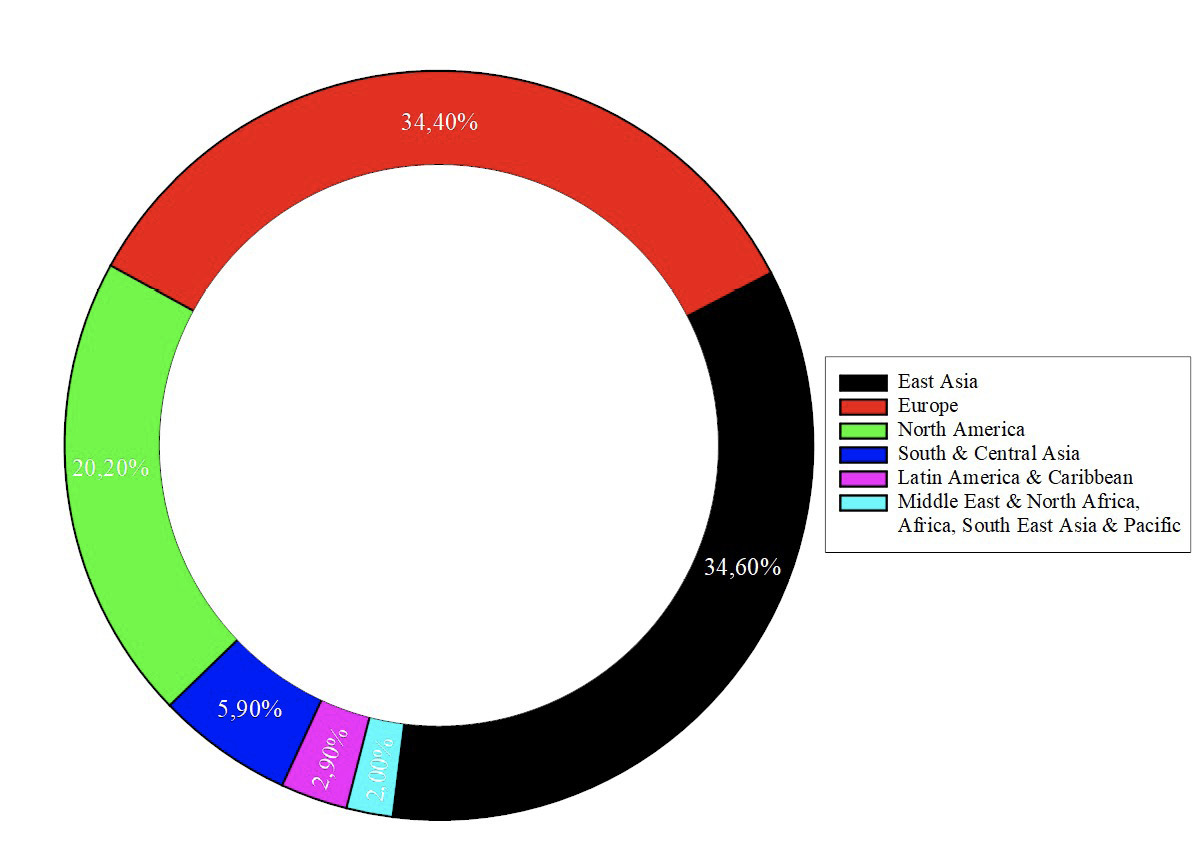
Figure 1. World’s wind power installed capacity by region. Source: Author’s own creation, using [6].
Europe
In this region, with wind energy being the second largest form of power generation capacity in Europe, renewable power generation technologies have been constantly advancing. Many countries in Europe are among the greatest wind energy producers in the world, such as Spain, Italy, Germany, UK and France. The region has a total net installed capacity of 168,7 GW, where Germany has the largest installed wind power capacity by 56,132 GW followed by Spain by the end of 2017 [7].
Even though Europe has been developing onshore and offshore wind energy, in this work only the first one will be considered as this is the only type of production existing in Costa Rica.
In this region, a typical structure of 2 MW wind turbine installed has the capital costs shown in figure 2. The leading cost is the wind turbine with 75,6 % of the total cost, followed by the grid connection, foundation and land rent costs. Electrical installation, consulting, financial, road construction and control system costs are less significant in the investment cost of a wind project in Europe.

Figure 2. Installed capital costs for a 2 MW wind turbine in Europe. Source: Author’s own creation, using [8].
The cost of the kWh depends upon the wind conditions. In areas where there’s only 1700 hours per year in which the wind enables the turbine to work in full load, then each kWh will have a calculated cost of 10,04 cents of dollars. If those full load hours increase to 2300, then the cost will be reduced to approximately 0,0790 $/kWh, and finally, if the full load hours per year are 2900 then a cost of approximately 0,0627 $/kWh will be achieved [8].
China
Since China is the country which produces the largest amount of wind energy, the analysis of this region is the most relevant for this work. By 2016, China had reached an installed capacity of 149,44 GW, which accounts for the 32 % of the total capacity in the world, and was followed by the United States and Germany [7]. It could be argued that what makes China such a great wind power producer is their industrial policies, which promote the manufacture of their own equipment, as consequence, the prices of the most important investment costs are drastically reduced. Just in 5 years (2007-2012), China accomplished a reduction of 50 % in the price of each kW from a wind turbine of a 1,5 MW which could explain their great success with this type of energy [9]. Another aspect that has greatly helped China is that most of the small wind energy markets in the world are supplied by either European or Chinese turbine manufacturers. This led China to emerge as a manufacturing hub for these locations and markets [10].
Studies have compiled some data using certain assumptions in order to estimate the average capital cost of a 100 MW wind farm located in China, which are shown in figure 3.
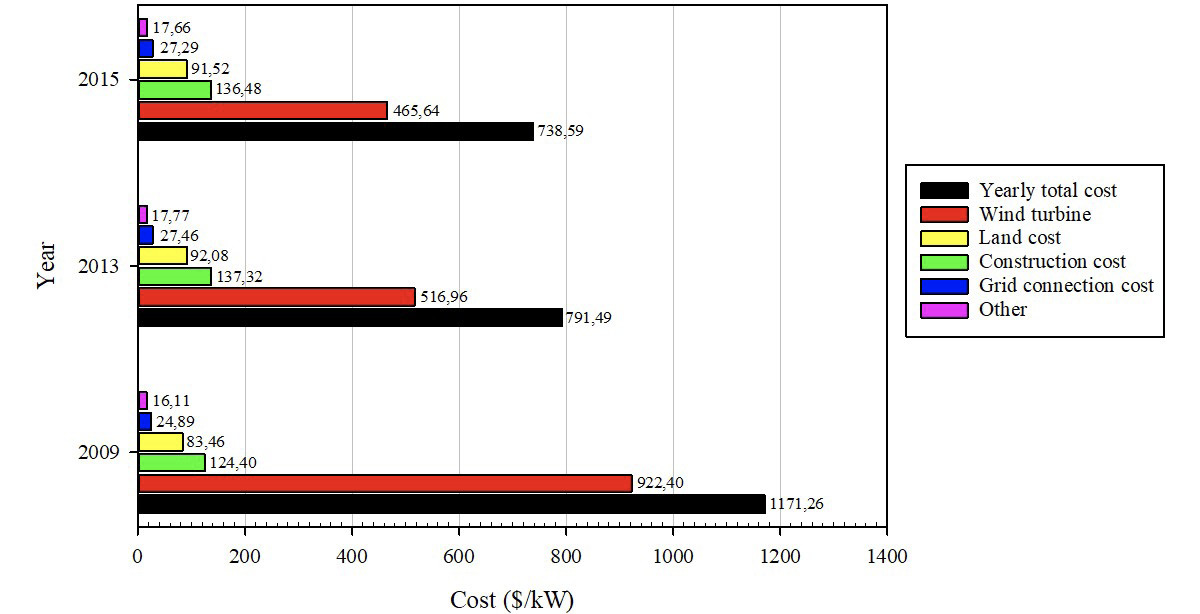
Figure 3. Investments for a 100 MW wind farm in China by year. Source: Author’s own creation, using [9].
The data in Figure 3 shows that in China, by 2015, a wind farm of 100 MW had a capital cost of approximately 738,55 $/kW. The costs in China are lower than other parts of the world due to their policies. This may explain why China is the leader in wind energy production in the world.
United States
In the United States, land-based wind energy production has an installed capacity of 90 GW. However, studies have shown that it has a potential installed capacity of 10 995 GW [11]. This shows the great potential this country has to reduce air pollution and water consumption due to energy production. In 2015, the capital cost of a 200 MW wind farm in the United States was 1690 $/kW [12]. The capital costs of a wind farm in the United States by 2017 are shown in figure 4.
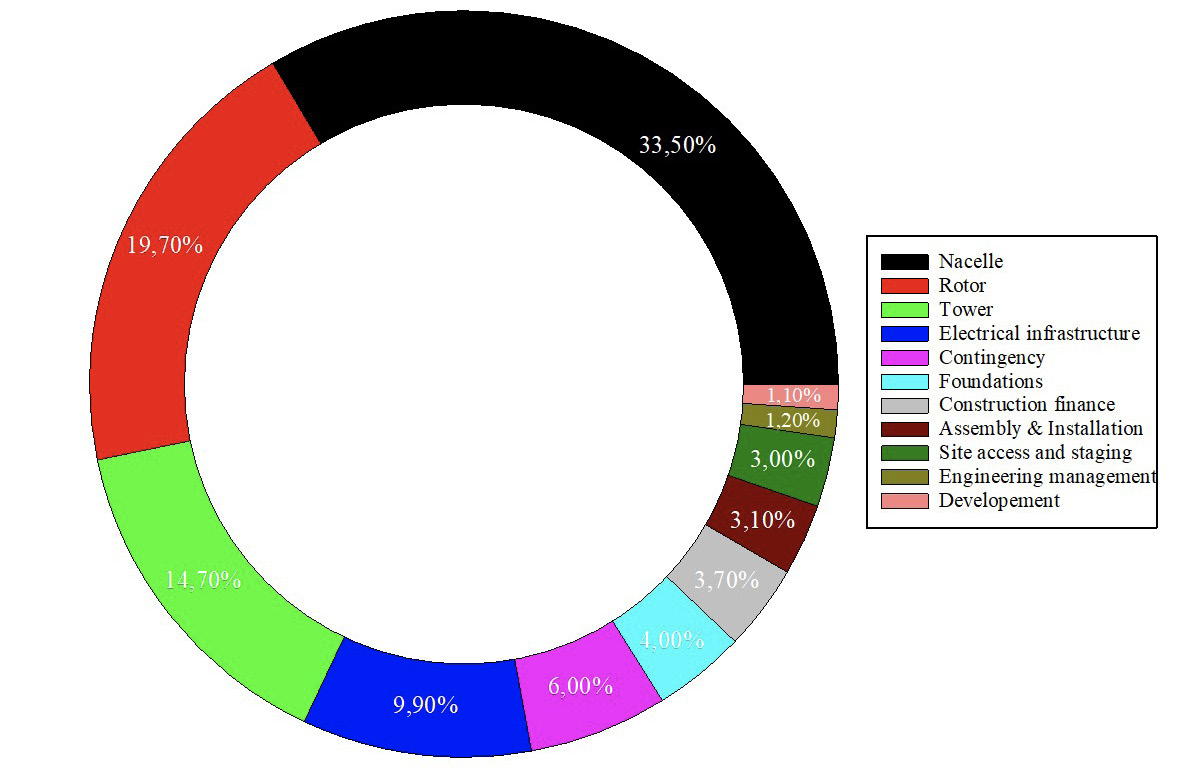
Figure 4. Installed capital costs for the land-based reference wind power plant project. Source: Author’s own creation, using [13].
The capital costs of the turbine are 67,9%, while the other 32,1% are distributed in financial costs and the construction of the station in which the wind farm will be based. The annual operation and maintenance cost in a 2 MW land-based turbine is 51 $/kW. This includes operations for 23 $/kW/yr (includes land lease cost) and maintenance for 28 $/kW/yr [12].
Latin America
In Latin America, three quarters of the total capacity of wind energy resides in Brazil and Mexico. In the last years, wind energy has been the most developed type of renewable source and has had the most penetration in Latin American markets [14]. Consequently, its electric industry is one of the least polluting in the world [15]. Brazil, which is the leader of Latin America in terms of installed capacity, has been growing substantially in this regard, and it is projected to become one of the greatest powers in wind energy [14]. Brazilian wind power leadership could be because this country was one of the early adopters of this technology. In fact, the government’s ten-year energy development plan forecasts the country to reach 28,5 GW of wind capacity by 2026 [16]. However, due to the recent recession of Brazil’s economy, the South American giant has been holding from starting new wind energy related projects. This could hurt Brazil’s image in terms of wind energy in the area [15]. Many nations in Latin America do not have stable economies, and thus their funds are invested in more urgent matters.
On the other hand, some countries have been developing and advancing in terms of wind energy. This might be due to approved legislation, which provide better conditions for wind energy developments. For example, Chile requires that the country generates at least 20% of its total electricity from renewable resources. Argentina and Mexico have followed this trend, proposing similar laws [15]. Mexico has set a clean energy target for the power sector of 35 % by 2024 [16]. Due to this legislation the region has been leading the global investments in wind energy. The Global Wind Energy Council (GWEC) estimates that Latin America will add up to 25 GW of wind energy in the next 5 years [17]. The World Bank has been the greatest provider of financial aid for these renewable energy projects. In Brazil, the State Development Bank emitted $2700 million in loans in 2014, for investments in wind power projects [17].
This region has a great potential to develop great wind energy industries. Since the 1990s, wind energy has been employed to supply public services. Costa Rica, Nicaragua, and Honduras have been preparing new facilities for wind energy production, whereas Panama is just joining these countries as well. This just shows the potential that Central America possesses [18].
Figures 5 and 6 show the annual installed capacity growth by world region. From 2009 and 2014 the growth in Latin America increases every year. Although, the installed capacity in this region is not even close to the leading regions shown in Figure 6. In 2014 an important growth occurred, which triples the one of the previous years. Then the growth decreased, but keeping higher than Africa, Middle East or Pacific regions. For the world leading regions, Europe growth is stable, and Asia has several peaks of huge quantities of MW installed every year. This shows that these regions have economic models that strongly pursue high numbers of installed wind energy per year [19].
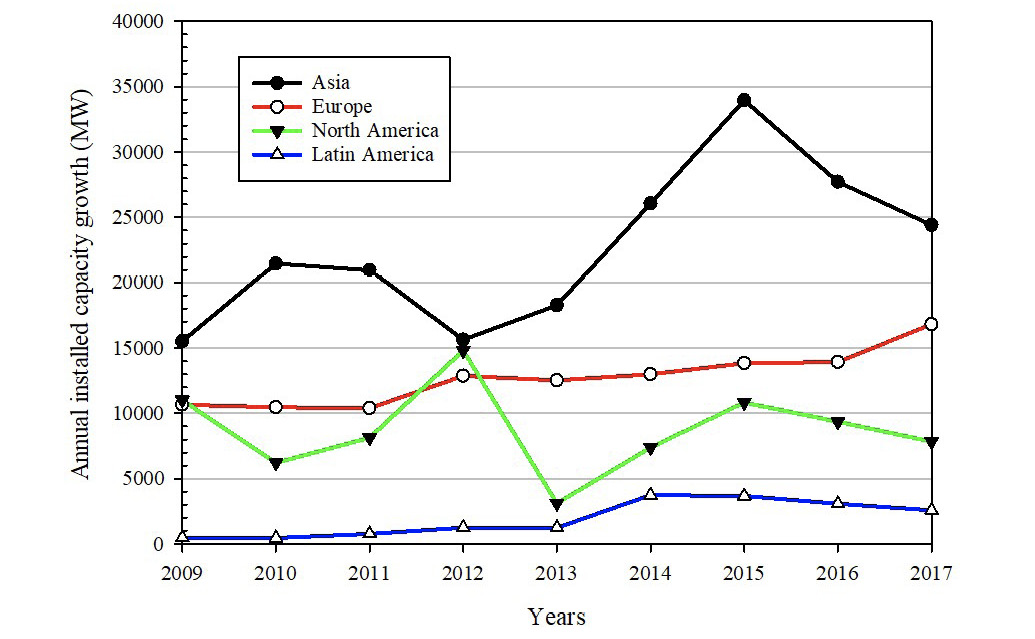
Figure 5. Annual installed capacity growth in leading regions. Source: Author’s own creation, using [16].

Figure 6. Annual installed capacity growth and other regions. Source: Author’s own creation, using [16].
Wind power in Costa Rica
Costa Rica was the first Latin-American country that produced electricity by wind energy [19]. Since the late 1940s, Costa Rica has set the goal to become a green country and has made multiple diplomatic decisions to second this sustainable development desire [20]. It began the generation of wind power in 1996 and nowadays has already installed 18 wind farms throughout the country, owned by the government and private companies. Currently, Costa Rica has the goal of fully reducing the carbon emissions and becoming independent of non-renewable energy [21]. In this country, wind power generation has been increasing through the years, and by 2017 wind power was the second most important source of energy, accounting for 11,5 % of the total energy production.
In 2017 Costa Rica reached 1288 GWh in total while in 2016 the total wind power generated was 1147 GWh. In Figure 7 it is shown the growth of wind energy production in Costa Rica from 2010 and 2017, where the total in increased for this period was 929 GWh [3].
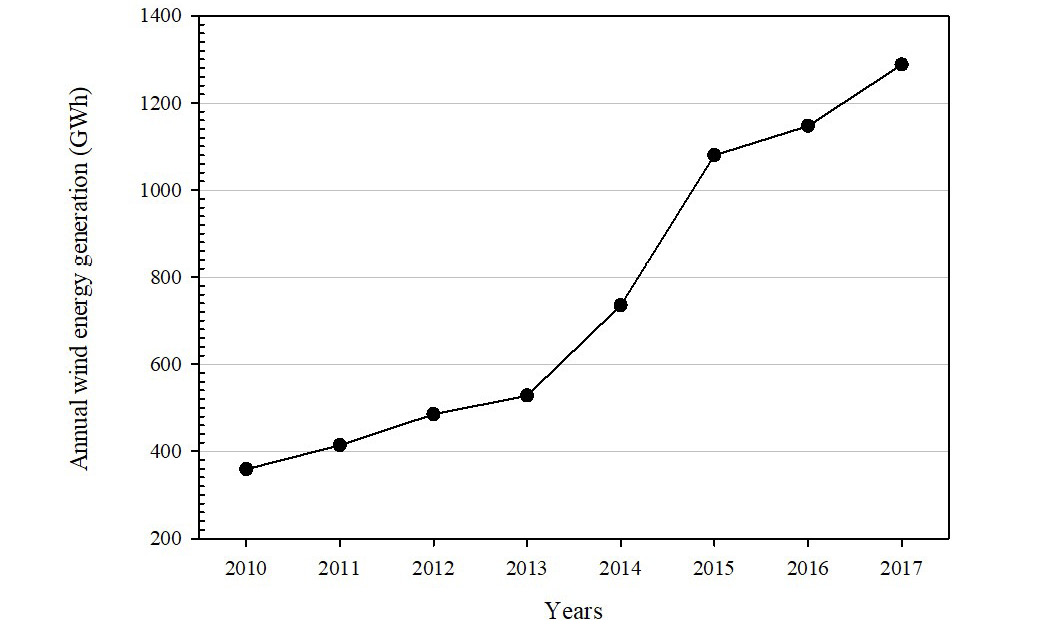
Figure 7. Wind power generation in Costa Rica through the years. Source: Author’s own creation, using [3].
Methodology
In order to achieve the objectives of this research, a scientific methodology was proposed and followed throughout the investigation. Firstly, a literature review regarding regions around the globe such as China, the United States, Europe, and Latin America. For this work, scientific research papers were considered the primary source of information. Nevertheless, due to the fact that economic-related information is limited in such references; reports of non-governmental entities were employed as well as information obtained from other sources such as reliable newspapers. Furthermore, a search was perform employing the most relevant topics for this research, such as wind farms, wind energy economics, and wind energy maintenance. The variables of interest were the installed capacities in these regions, constructions and maintenance costs, and the investments made. Finally, the data recollected was filtered by year; and as it was of special interest to have an updated point of view, the sources of information were limited to years 2015 or later.
Then a brief introduction of the current state of wind power in Costa Rica was made, using data regarding the installed capacity of the country through the years, and Costa Rica’s individual wind farm installed capacities, to provide greater details of this information.
Once this data is presented, a comparison is performed with the different regions studied previously, to expose the current state of Costa Rica’s wind energy development. Firstly, a macroenvironment analysis was be performed, by comparing the advancements in wind energy capacity around the globe with Costa Rica’s. Afterwards, a microenvironment analysis was carried out to compare the region in which Costa Rica resides. This will help set foot on the main challenges this Central American country might be facing. In order to understand these previously mentioned challenges, a case study specific to this research is presented, and finally the weaknesses in the development of technologies, such as wind energy in Costa Rica, will be exposed.
Results and Discussion
Wind power in Costa Rica vs the rest of the World
Aiming to compare the wind power installed capacity growth in Costa Rica and the world, Figure 8 shows both with different scales. This artificial comparison reveals that the growing tendency is similar. Although in some years a stagnation occurred in Costa Rica, from 2013 to 2016 its growing rate was higher than the world rate.
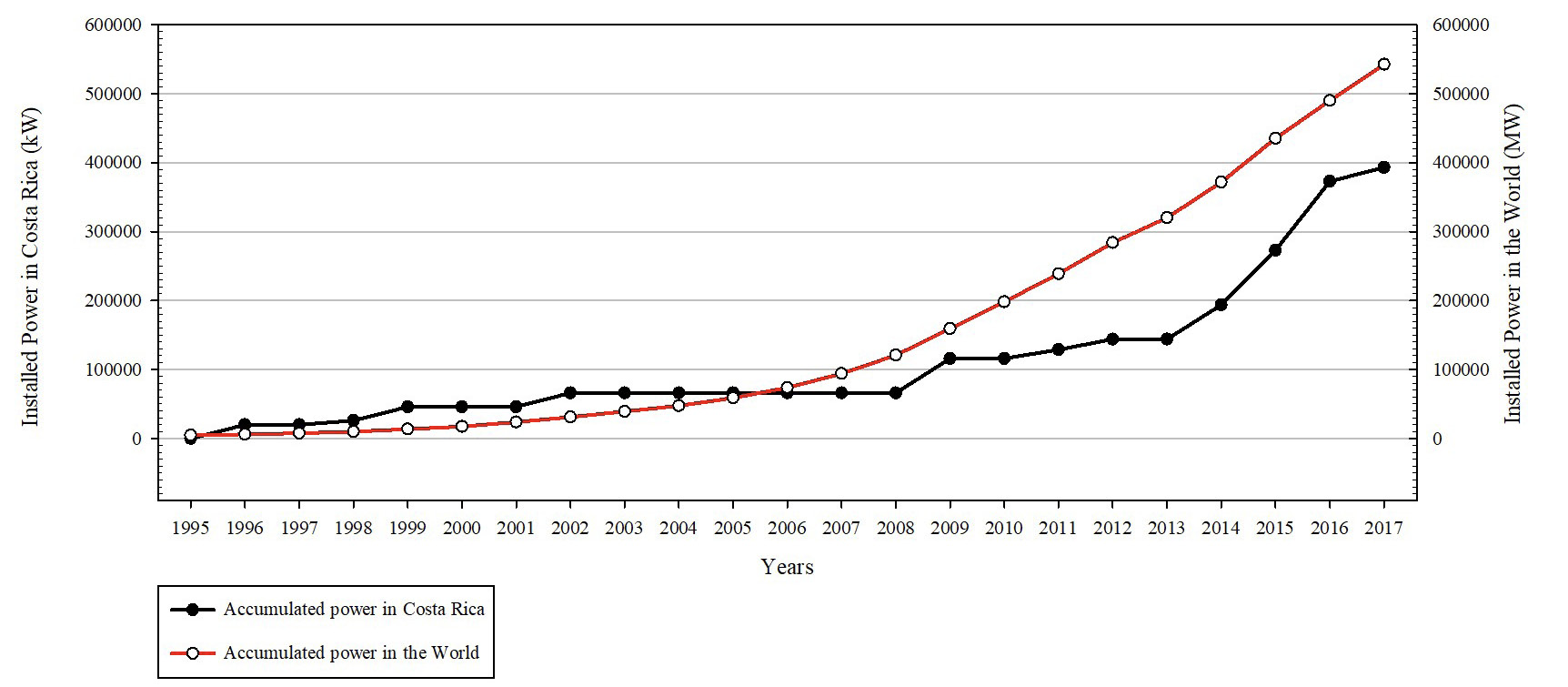
Figure 8. Installed capacity of Costa Rica vs the World in different scales. Source: Author’s own creation, using [16] and [22].
On the other hand, it’s clear that the world’s installed capacity has grown in a stable way through the years. These increments are very regularly each year and there is no stagnation, and considers all the countries, where several of them contribute with great capacity additions each year [16].
Comparison with Latin America
Figure 9 shows the installed capacities of some countries of the region. Although Costa Rica is number six in installed capacity, Figure 10 shows the ratio between installed capacity and territory, putting Costa Rica in the second place, way ahead of Brazil and Mexico. This is a great achievement because Brazil was one of the pioneers of wind energy in the region [23].
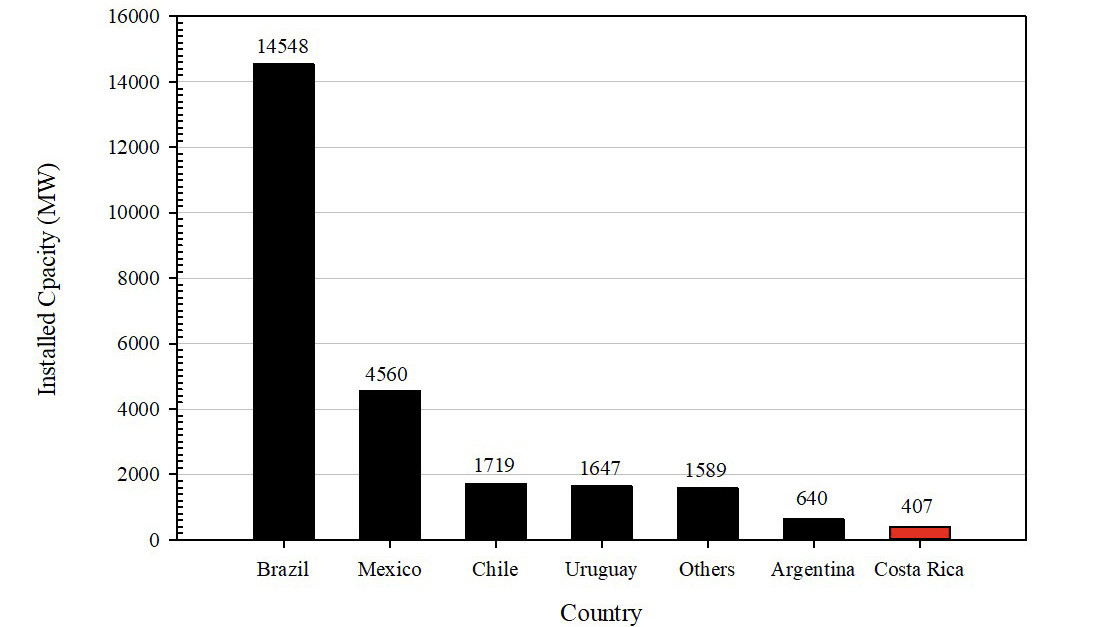
Figure 9. Installed capacity in Latin America. Source: Author’s own creation, using [24].
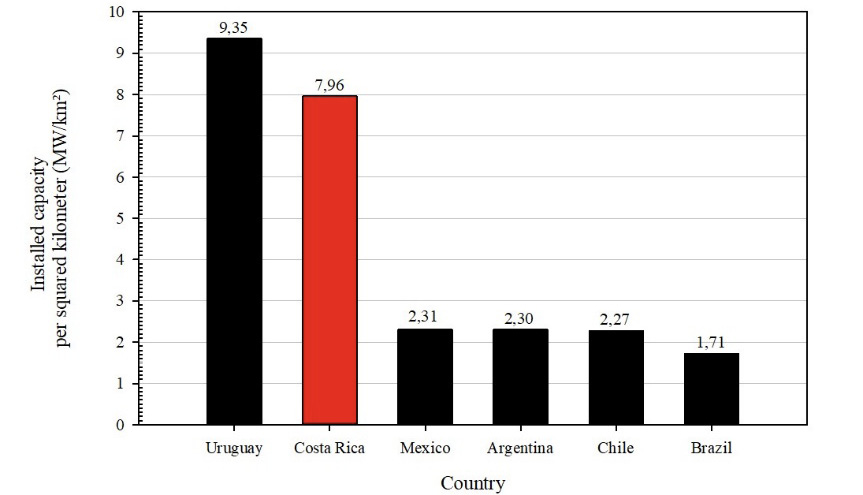
Figure 10. Installed capacity per square kilometer in Latin America. Source: Author’s own creation, using [24].
Figure 11 shows some wind farm costs in Latin America. Mexico has the lowest average for $/W of this sample. This cannot be explained exclusively by scale effects, big projects in Panama and Chile are still more expensive than in Mexico as it can be observed from Figure 11. It may explain why Mexico is the second largest wind energy producer in the region. If Figure 11 is compared with the data of total installed capacity in Figure 10, the countries with the smallest average investment costs per installed capacity are the ones with the greater total installed capacity. This means that the average decreasing cost is directly related to increasing wind power installed capacity. For smaller countries, wind energy deployment is more costly than in large markets. This may suggest that Latin America’s smallest wind energy producers are overpaying for their wind energy.
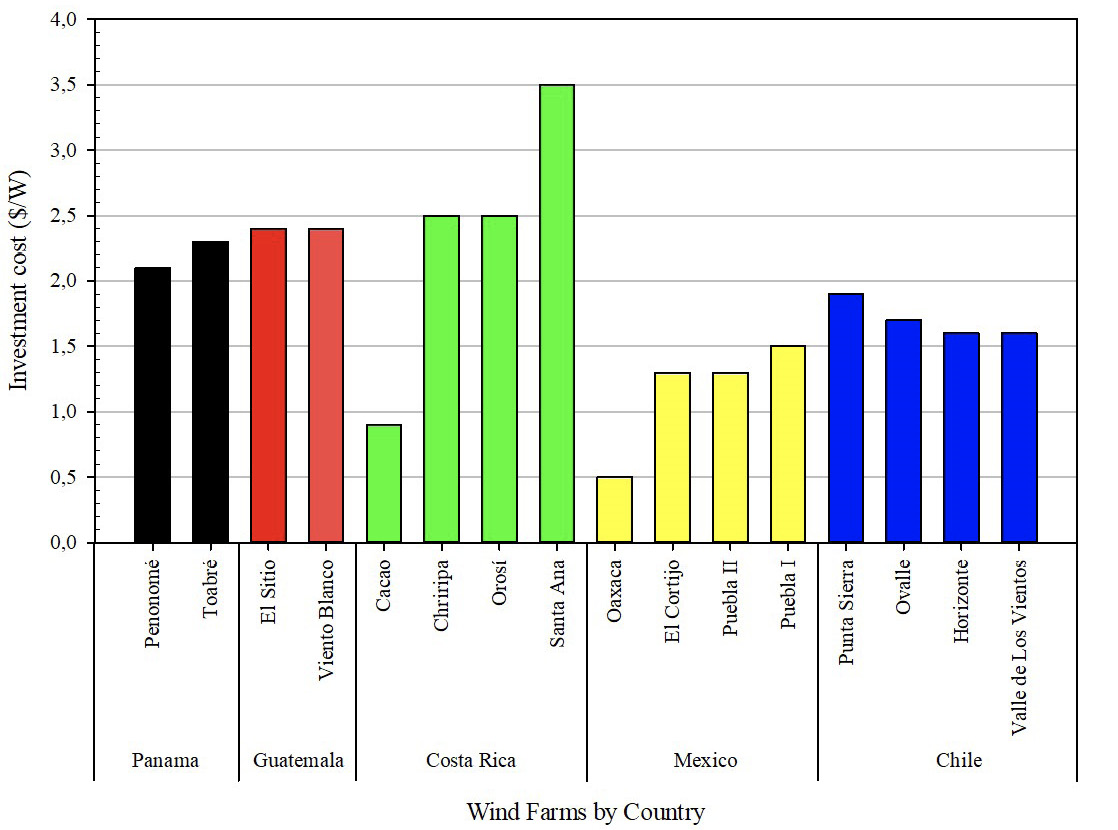
Figure 11. Wind power investment costs in Latin America. Source: Author’s own creation, using [3], [25], [26], [27], [28] and [29].
In figure 11 can be seen that in Chile the MW cost is similar between wind farms, but in Costa Rica Santa Ana MW is extremely expensive compared with Cacao. In Mexico, Puebla I MW costs three times Oaxaca MW.
Tejona study case
An upgrade in the 20 MW Tejona wind farm is presented as a study case in Costa Rica. Table 1 shows local and foreign costs. The foreign charges are significantly larger than the local ones. This can be used for further economic analysis, suggesting that if some expenses were made locally, each MW will be cheaper.
Table 1. Local, foreign, and total expenses of Tejona’s wind farm.
|
Activity |
Local cost ($) |
Foreign cost ($) |
Total cost ($) |
|
Environmental viability |
24 411 |
3003 |
27 414 |
|
Design |
533 199 |
62 265 |
595 464 |
|
Project administration |
2 315 330 |
174 496 |
2 489 826 |
|
Civil work |
6 440 649 |
1 431 553 |
7 872 202 |
|
Acquisition and installation |
- |
30 252 007 |
30 252 007 |
|
Electrical work |
862 983 |
3 391 952 |
4 254 935 |
|
Final activities |
5961 |
2058 |
8020 |
|
Tests |
11 065 |
- |
11 065 |
|
General total |
10 193 598 |
35 317 334 |
45 510 933 |
Source: Author’s own creation, using [3].
Figure 12 makes a detailed breakdown. The electromechanical devices are the greatest expenses. If compared with the costs in the United States (cost of the wind turbine 67,9 %), Costa Rica pays more percentage for the equipment (71,76 %), but if compared with Europe (75,6 % in wind turbines), the percentage in Costa Rica is lower.

Figure 12. Cost distribution of Tejona’s wind farm. Source: Author’s own creation, using [3].
The operating costs in this study case decrease from 2015 to 2017. Being $ 1017 in 2015, $ 886 in 2016 and $ 831 in 2017 reported by [3]. Maintenance costs also decreased, being $ 1986 in 2015, $ 1922 in 2016 and $ 1252 in 2017.
If these figures are compared with the USA operation and maintenance costs, strikes one’s attention that in Costa Rica each year the maintenance costs are around twice the operating costs, just like in the USA wind farm case presented.
The maintenance costs of the Tejona wind farm follow the same line as the cost of operation. The higher maintenance cost was in 2015, and the lowest in 2017. Those costs have a difference of $ 719,97. This difference may be due to the significantly reduce of some expenses, such as the number of spares needed for the machinery or the hiring costs for the machinery maintenance. As a result, the average of the cost of operation is $ 894,75 and for the cost of maintenance is $ 1688,21.
Challenges in wind energy development
It is crucial to remember a very important factor that might substantially affect the development of renewable energies in this country, which is the urgent economic crisis that Costa Rica is currently going through. Many experts have discussed whether such crisis will amplify environmental concerns, making wind energy a priority in terms of future development, or if would do the exact opposite [30].
An interesting regulation that must be observed in Costa Rica is that Law 7200, Art 3, states: “It is hereby declared of public interest the electric power purchase by ICE to cooperatives and private companies, for which at least 35% of their capital is owned by Costa Rican citizens, and that establish limits capacity electric power plants to exploit the small-scale hydraulic potential and non-conventional energy sources.”
It may be considered as an advantage for national investors, but may be a disadvantage for multinational investors, because the 35% of national inversion must be verifiable.
Conclusions
In this work, the wind power development in the most important world regions and Costa Rica is studied. Among the factors included in this analysis are maintenance, operation, equipment and per kW installation costs. Moreover, the role of legislation and government policies were considered as well. In view of the different aspects noted above, the following conclusions can be drawn:
•The main cost in a wind farm is the turbine, in Costa Rica the weight of the turbine related to the total cost is similar than the rest of the world.
•Wind farm inversion cost in $/W in Costa Rica is uneven compared with Mexico, Chile, Panamá and Guatemala.
•For smaller countries, wind energy deployment is more expensive than in large markets. In Costa Rica, a wind farm may have on average double the price of $/W than Mexico.
•Brazil and Mexico are the most predominant wind producers in Latin America; however Costa Rica is in second place in terms of the ratio between installed capacity and territory.
•Several difficulties affect the process of building and maintaining a wind power plant in Costa Rica, most items must be imported, bringing the cost of the investment up.
Costa Rica’s electric wind power development, as it is shown by the analysis, is a successful model to follow not only by other emergent economies but also by the more developed economies. Costa Rica’s mostly entirely renewable electric energy matrix, as well as the achievements and policies for wind power, contribute to some of the United Nations sustainable development goals and to its government’s economy decarbonization plans. For many industrialized countries, these still remain among there global warming goals.
References
[1] G. Richmond-Navarro, R. Madriz-Vargas, N. Ureña-Sandí and F. Barrientos-Johansson, “Research Opportunities for Renewable Energy Electrification in Remote Areas of Costa Rica,” Perspectives on Global Development and Technology, 2019, vol. 18 no. 5-6, pp. 553-563. https://doi.org/10.1163/15691497-12341530
[2] Grupo ICE, “Matriz Eléctrica, un Modelo sostenible único en el mundo” 2015.
[3] Departamento de Planificación y Desarrollo Eléctrico del ICE, “Consultas de energía eólica en Costa Rica,” 2018.
[4] V. M. Salas-Mora and G. Richmond-Navarro, “Safety design of a hybrid wind-solar energy system for rural remote areas in Costa Rica,” International Journal of Renewable Energy Research, vol. 10, no. 1, pp. 33–44, Mar. 2020. https://www.ijrer.ijrer.org/index.php/ijrer/article/view/10263
[5] IRENA, “Renewable Power Generation Costs in 2017,” International Renewable Energy Agency, 2018, pp. 89-113.
[6] World Energy Council, “Energy Resources: Wind”. https://www.worldenergy.org/data/resources /resource/wind/
[7] D. Fraile and A. Mbistrova, “Wind in power 2017—Annual Combined Onshore and Offshore Wind Energy Statistics,” Wind Europe, 2018.
[8] S. Krohn, P. E. Morthorst, and S. Awerbuch, “The Economics of Wind. Energy,” European Wind Energy Association, EWEA, 2009
[9] L. Liu, W. Zhang, C. Zhao, and J. Yuan, “The Economics of Wind Power in China and Policy Implications,” Energies, 2015, vol. 8, no. 2, pp. 1529–1546. https://doi.org/10.3390/en8021529
[10] R. Lacal-Arántegui, “Globalization in the wind energy industry: contribution and economic impact of European companies,” Renewable Energy, vol. 134, pp. 612–628, Apr. 2019. https://doi.org/10.1016/j.renene.2018.10.087
[11] A. Lopez, B. Roberts, D. Heimiller, N. Blair, and G. Porro, “U.S. Renewable Energy Technical Potentials: A GIS-Based Analysis,” National Renewable Energy Laboratory, NREL, 2012. https://doi.org/10.2172/1219777
[12] C. Mone, M. Hand, M. Bolinger, J. Rand, D. Heimiller, and J. Ho, “Cost of Wind Energy Review,” National Renewable Energy Laboratory, NREL, 2015. https://doi.org/10.2172/1351062.
[13] T. Stehly, P. Beiter, D. Heimiller, and G. Scott, “2017 Cost of Wind Energy Review,” United States, 2018. https://doi.org/10.2172/1475534.
[14] P. De Montmollin, “Energía Electica Informe de Inteligencia: Energía eólica a un promete volar alto en América Latina,” BNamericas.
[15] P. De Montmollin, “Energía Eléctrica Informe de Inteligencia: Energía eólica crece en América Latina pese a problemas económicas,” BNamericas.Global Wind Report.
[16] GWEC, “Annual Market Update 2017,” Global Wind Report, 2018, pp. 19–21.
[17] M. Craze, “Energía Eléctrica Informe de Inteligencia: La primavera de la energía eólica en América Latina,” BNamericas.
[18] N. Edgardo-Portillo, S. Arita-Portillo, J. Martinez-Martinez, and C. H. Ortega-Jimenez, “A review of wind energy literature: alternative technologies for Central America,” MATEC Web of Conferences, vol. 293, 2019. https://doi.org/10.1051/matecconf/201929305003.
[19] L. Contreras and P. Sauma, “Perspectivas de la energía eólica en Costa Rica: estado, retos y oportunidades,” Observatorio del Desarrollo, 2017, pp. 42.
[20] L. Feoli, “Advancing National Interests through International Norms: The Case of Costa Rica: Ludovico Feoli Comments on a Small Central American State’s Approach to Maximizing Its International Diplomatic Projection,” New Zealand International Review, vol. 45, no. 4, p. 16, Jul. 2020.
[21] A. Florescu, S. Barabas, and T. Dobrescu, “Research on Increasing the Performance of Wind Power Plants for Sustainable Development,” Sustainability, vol. 11, no. 5, p. 1266, Feb. 2019. https://doi.org/10.3390/su11051266.
[22] GWEC, “Global Wind 2006 Report,” Global Wind Energy Council, 2007, pp. 6–11.
[23] M. Simas and S. Pacca, “Socio-economic benefits of wind power in Brazil,” Journal of Sustainable Development of Energy, Water and Environment Systems, vol. 1, no. 1, pp. 27–40, Mar. 2013. https://doi.org/10.13044/j.sdewes.2013.01.0003.
[24] M. Pierrot. “Wind energy database.” The Wind Power. https://www.thewindpower.net/
[25] Reve. “Eólica en Panamá: parque eólico de Penonomé representa la mayor inversión en energías renovables.” Evwind. https://www.evwind.com/2015/11/09/eolica-en-panama/.
[26] CentralAmericaData. “Inicia construcción de parque eólico de 66 MW.” https://www.centralamericadata.com/es/article/main/Inicia_construccin_de_parque_elico_de_66_MW
[27] J. F. Lara. “Proyecto de CNFL genera energía eólica más cara de Costa Rica.” La Nación, 2015. https://www.nacion.com/el-pais/servicios/proyecto-de-cnfl-genera-energia-eolica-mas-cara-de-costa-rica/ZUVYDYDJMNBODGF4L5R7S3TY3Q/story/.
[28] Acciona Corporativo. “Quinto parque eólico de ACCIONA en México y primero en ponerse en marcha de los vinculados a la Reforma Energética.” https://www.acciona-energia.com/es/areas-de-actividad/eolica/instalaciones-destacadas/parque-eolico-el-cortijo/
[29] Reve. “Eólica en Chile: Inauguran el primer parque eólico con inversión china.” https://www.evwind.com/2018/08/28/eolica-en-chile-inauguran-el-primer-parque-eolico-con-inversion-china/
[30] T. Greve, “Environmental discourses during times of economic crisis: A content analysis of the media in Costa Rica,” 2019. http://urn.kb.se/resolve?urn=urn:nbn:se:uu:diva-375125.
1 Instituto Tecnológico de Costa Rica. Costa Rica. Correo electrónico: grichmond@tec.ac.cr
https://orcid.org/0000-0001-5147-5952
2 Instituto Tecnológico de Costa Rica. Costa Rica. Correo electrónico: estejim17@gmail.com
https://orcid.org/0000-0002-2576-0431
3 Instituto Tecnológico de Costa Rica. Costa Rica. Correo electrónico: vguerrerobonilla@gmail.com
https://orcid.org/0000-0001-6821-0504
4 Universidad de Costa Rica. Costa Rica. Correo electrónico: pedro.casanova@ucr.ac.cr
https://orcid.org/0000-0001-8508-6293
5 University of North Carolina at Chapel Hill. USA. Universidad de Costa Rica. Costa Rica. Correo electrónico: henry.monge@ucr.ac.cr
https://orcid.org/0000-0002-9257-7813
6 Los autores aquí firmantes están de acuerdo con la versión final de este documento y hacen constar que la conceptualización, preparación y corrección del artículo se realizó según la siguiente distribución: GRN 65%; EJQ 10%; VGB 10%; PCT 10%; HMC 5%.